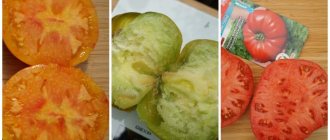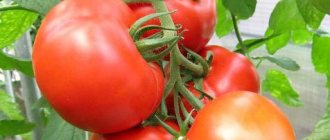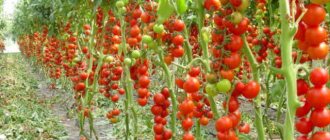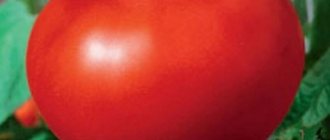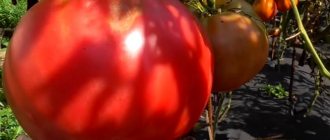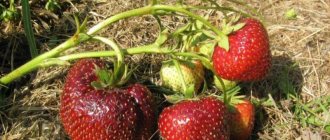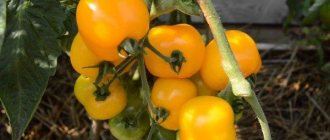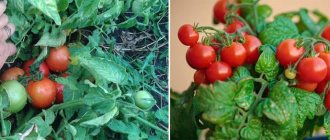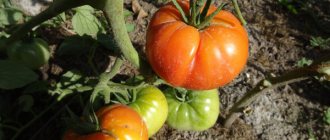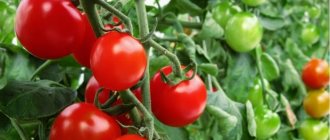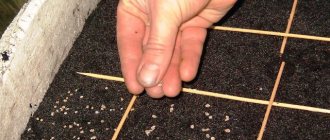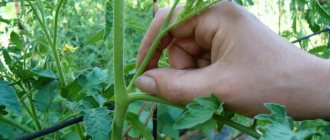When choosing tomato varieties for Belarus, first of all you need to pay attention to plants zoned to local conditions. A number of institutes and agricultural enterprises in Belarus are engaged in their breeding and have achieved excellent results. Seed companies in Holland produce tomatoes that are maximally adapted to the conditions of a given region. They offer tomato varieties for Belarus, including many high-yielding hybrids for protected soil. Also suitable for the moderately warm Belarusian summer are varieties of Siberian selection that can easily withstand weather stress in unprotected soil conditions. The choice is extensive, for every, even the most demanding taste.
The four agroclimatic zones of Belarus differ in the duration of frost-free periods and the amount of precipitation. These features are well known to owners of personal plots. Everyone tries to choose the best varieties of vegetables, taking into account their capabilities, crop rotation, sown area, and the presence of a greenhouse.
Many conditions influence the choice. But the main ones are the ripening time of tomatoes, their degree of adaptability to weather conditions, and yield. Everyone decides for themselves which varieties to choose. For many, the main argument is the exotic color, shape or size of tomatoes. It is more convenient to divide tomatoes into two groups, for open and protected ground.
Features of growing tomatoes in Belarus
The main difficulty in growing tomatoes in Belarus is the short, cool summer with lots of rain and cold snaps. Early maturing hybrids with a short growing season are selected for planting. Greenhouse varieties are in great demand among summer residents, since they provide a more reliable and stable harvest, rather than ground varieties, which often do not have enough heat and time to ripen.
Late-ripening varieties are also grown in greenhouses, which provide tomatoes until the end of summer. The best indeterminate varieties give a larger yield (up to 35-40 kilograms); they are cultivated in closed heated greenhouses. Semi-determinate tomatoes are planted with film cover; you can expect a yield of up to 15-20 kilograms per square meter.
In Belarus at the end of July, with large amounts of precipitation, many plants, including tomatoes, are at increased risk of late blight infection.
Treatment is recommended with a systemic fungicide at the end of June, and then again after 10 days. Before the end of fruiting, they are treated by contact method 2-3 more times with a break of 10 days.
Which tomato seeds are productive and stunted?
Every gardener wants to reap large harvests, which is why you need to purchase tomato seeds for growing, which will delight you with the number of fruits:
- The fruits of the Siberian Troika are valued for their sugary taste and versatility of use. Pepper tomatoes have a rich red color and weigh 350 grams. From one bush, sixty centimeters high, you can collect five kilograms of excellent fruits. On the first cluster, tomatoes ripen, reaching a length of fifteen centimeters.
- Juicy tomatoes weighing one hundred to two hundred grams adorn the Ballerina bushes. Fans of pink, pear-shaped fruits will love this variety. The height of the bush is sixty centimeters; tomatoes ripen after 100-105 days. Six to seven kilograms of tomatoes are harvested from one square meter.
- Carpal determinant Moscow pear grows up to eighty centimeters in open ground, and up to a meter in greenhouses. Pepper-shaped fruits are fleshy and tasty. With a yield of four to five kilograms per bush, a lot of pickles are prepared from tomatoes for the winter.
- Standard plants include the Buyan, or Fighter, variety. Its stem is below fifty centimeters. Not picky, bears fruit well on light and fertile soils. The tomato tolerates drought and is resistant to viruses and fungi. Slightly elongated oval fruits are from the early ones, appearing 95-100 days after germination. There are two types - red and yellow. From one square meter, gardeners harvest up to nine kilograms of delicious tomatoes.
- The Rocker tomato is distinguished by its compactness. Red plum tomatoes reach a weight of one hundred grams and ripen 100-105 days after the first shoots appear. The variety represents high-yielding plants, because four to five kilograms of fruit are collected from one bush.
- Late varieties are represented by Mushroom Basket. The height of the stem is more than a meter, so the top must be pinched. The shape of the fruit is interesting; they are very ribbed, looking like a basket, as the name suggests. The weight of each fruit is 250-350 grams, and the tomato pulp is so tender and sweet that many summer residents grow them. With good care, the tomato will delight you with large fruits weighing half a kilogram.
- The Sanka variety is chosen by farmers for planting, as the yield reaches fifteen kilograms per square meter. Tomatoes are easy to care for using machines, since the bushes are low-growing, no more than half a meter. And the fruits produce a red color, weighing 80 grams.
- Early ripening tomatoes Little Red Riding Hood, or Rotkäppchen, came to us from German breeders. The maximum height of the bushes is forty centimeters, allowing them not to be tied up. Fruits weighing one hundred grams are characterized by light ribbing and excellent taste. Under the thin, smooth skin hides juicy purple flesh. Consistently high fruiting yields two to three kilograms of tomatoes from one bush. New products are popular among farmers. In their fields they produce thirty tons of tomatoes per hectare in excellent marketable condition.
Not only early-ripening varieties are famous for their high yields, but also those with late ripening periods.
Varieties of tomatoes most suitable for planting
Many good varieties have been created for planting in Belarus, taking into account the main agroclimatic regions of the country (the best are 4). Gardeners often grow non-registered species that take root well and produce consistently high yields.
When choosing tomato varieties, they also take into account the methods of use - some hybrids are not very good at preservation and are used only for salads.
Tomatoes for the greenhouse
The greenhouse growing method is the leading one in Belarus, so there are many good varieties.
Start
The bush grows up to 180 centimeters; a garter is required. Small tomatoes (50 grams) have a sweet taste and are used in canning and pickling. The yield is up to 15 kilograms per square meter.
Early-83
It ripens quickly – 95 days. 7-9 plants are planted per square meter, harvesting up to 8 kilograms. Tomatoes can be used in any way and retain their shape and excellent taste.
Mandarin duck
Beautiful smooth fruits of wonderful taste, they ripen together. Up to 9 kilograms are collected per square meter. Stores well and does not crack.
White filling
Small tomatoes with thin skin and juicy pulp. They are also used to obtain juice and paste. Weight – 80-140 grams. The bushes are low and do not require pinching.
Baby F1
It ripens on 94-113 days from friendly shoots. The quality of the fruit is good - sweet, size - up to 65 grams. They sing together, the total yield is up to 10 kilograms per square meter.
The plant is determinate, up to half a meter high. Grown in spring greenhouses. Not resistant to gray rot and septoria.
Verlioka plus F1
A hybrid with limited bush growth, produces up to 9 kilograms of tomatoes per square meter, fruits reach 140 grams. It is not susceptible to infection by fungal diseases; tomatoes are ready after 105 days from germination. The pulp is juicy, there are few seeds, located in four chambers.
Verlioka F1
The hybrid has an early ripening period, is well stored and tolerates transportation. Tomatoes ripen green when picked flat, retaining their taste and aroma. Not prone to cracking when exposed to excess moisture. Bush - up to one and a half meters, tomatoes on clusters of 3-5 pieces. Per plant – 4-5 kilograms.
See also
What is the shelf life of tomato seeds and how long does germination last?
Read
Red Arrow
A popular hybrid that grows well even in Siberia, produces a yield of up to 27 kilograms per square meter. The fruits ripen together, bright and dense. They can be stored for up to a month, but are poorly transported. Weight – 70-130 grams. The seeds are small and not noticeable when eaten. Does not require pinching, grows in beds and in greenhouse conditions, and is resistant to diseases.
Gift from a woman
The bush produces up to 30 fruits weighing about 200 grams. The tomatoes are juicy and sweet, with a thin skin, pink-red in color. Used fresh and for making juice and sauces. When planting, they require a larger area due to the large size of the fruits and spreading bush.
Tomatoes for open ground
When planting tomatoes outdoors, it is especially important to choose the right variety that is adapted to the agroclimatic conditions. The best results are shown by varieties of Belarusian breeders.
Many of them are already several decades old; they are reliable, unpretentious, and distinguished by their sweet taste, juiciness and aroma.
Profitable
The tasty fruits are red in color, they ripen together, the bush gives up the entire harvest before the onset of late blight, which is what Belarusian summer residents like. The low bush does not need staking or pinching. Fruits – 70-90 grams.
Ruzha (Rose)
A well-known variety of Belarusian selection with juicy sweet tomatoes. If harvested at the wrong time, tomatoes do not ripen and retain their taste and density. You can harvest in 7-10 days. A one-time pinning is required. Used for canning and fresh. Up to 4-5 bushes are planted per square meter, the yield is 10-12 kilograms.
Moskvich
Small tomatoes (50 grams) grow on low bushes and have a round shape. The pulp is dense and very sweet. By planting 8-9 bushes per square meter, you can harvest up to 5 kilograms of tomatoes per season. They have time to ripen in a short period of heat, 100 days - a full cycle from germination to harvest.
Excellent 176
A wonderful variety with thin, dense skin that is resistant to cracking. Sweet and fragrant tomatoes with juicy pulp reach a weight of 100 grams and ripen in 110 days. The bushes grow up to 60 centimeters, the fruits - 3-4 pieces per cluster. They produce 10 kilograms of tomatoes per square meter.
Peremoga
A good old variety created in Belarus. We love it among gardeners for its stable harvest and high resistance to any vagaries of weather. Tomatoes ripen well when picked early, do not crack, and are stored for a long time. Fruit weight – up to 100 grams. Used for preparations and fresh. The taste is excellent.
Morning
The variety of Moldavian selection fell in love with Belarusian summer residents. The fruits are sweet and fragrant, up to 100 grams, and do not spoil during transportation. Used fresh.
The most productive tomatoes
Yield types of tomatoes are in particular demand among gardeners. They allow you to grow the required number of fruits even in a small area, without spending extra effort on a large number of seedlings.
Stick
This tomato variety produces a yield of up to 30 kilograms per square meter. The bush has a strange appearance - there are no side shoots, the leaves are arranged in bunches. Tomatoes ripen on a pillar-like stem. Requires reliable, repeated garter. The quality of the tomatoes is excellent - sweet, shelf-stable, tasty fresh and prepared.
Budenovka
The color of the fruit is pink-red, the taste is slightly sour, the weight is up to 250 grams. Tomatoes last a long time and do not deteriorate during transportation. Suitable for a variety of uses, including freezing.
Mushroom basket
Tomatoes of this variety have a bizarre ribbed shape and weigh up to 300 grams. They grow on a powerful thick stem up to one and a half meters high. Under unfavorable conditions, they may lack pulp and juiciness and remain empty. Requires pinching and tying.
Classification of varietal groups and their brief description
When choosing tomato varieties for growing on plots, gardeners take into account many characteristics: ripening time, shape and color of tomatoes, size of bushes. To classify plants, all varietal characteristics are taken into account.
Height differences
According to the height of bushes and stems, five types of plants are distinguished:
- standard - powerful, strong stems do not grow higher than 55-60 cm, so the plants do not need staking;
- superdeterminate tomatoes form compact bushes 30-60 cm high and are distinguished by early fruiting;
- determinate bushes grow up to a meter high, the stems need additional support;
- Semi-determinate tomatoes develop well in greenhouses. Bushes 150-200 cm high must be tied up;
- indeterminate - stem growth is practically unlimited. It is usually practiced to pinch the tops of the stems at a height of 200-230 cm. Each bush must be tied to a support, and during the season the stems are pinched to prevent thickening of the bed.
Tall varieties are usually not planted in open areas, since the plants develop slowly and the crop ripens late.
Ripening time
If you focus on this characteristic, then you need to take into account the conditions for future growing of plants (open ground, greenhouse) and natural features.
Ultra-early ripening varieties begin to bear fruit in 75-82 days. The bushes develop in short daylight conditions, so tomatoes have a low sugar content.
Early-ripening tomatoes have a growing season of 90-95 days and are in great demand because they are optimal for producing early, tasty fruits.
Mid-season tomatoes ripen 100-115 days after seed germination. Recommended for planting in greenhouses and open beds.
Expert opinion
Stanislav Pavlovich
Gardener with 17 years of experience and our expert
Ask a Question
Advice! It is advisable to plant late-ripening tomatoes in greenhouses so that early autumn frosts do not interfere with harvesting. The growing season is 120-130 days.
When to plant tomatoes in Belarus?
Tomatoes require a long period of growth, so they are planted as seedlings. It will take 5-8 weeks to receive it. It is better for inexperienced summer residents to buy ready-made seedlings in greenhouses, as skills and experience are required to obtain high-quality healthy material.
See also
Varieties of tomatoes of Kirov selection for growing in greenhouses and open ground
Read
Seed sowing dates for Belarus:
- for open planting - early April;
- for heated greenhouses – 20.02-10.03;
- for covered greenhouses – 10.03-30.03.
Determinate varieties grow in 5-6 weeks, indeterminate varieties in 7-8. Bushes with unlimited growth are ready for planting when the first cluster blooms soon. The timing of transferring seedlings to the ground is the end of May-June. Seedlings should be planted in greenhouses as soon as the planting material is ready. When planting in an open way, you have to adjust the timing depending on the weather.
Important: the planting dates for each variety are indicated on the seed packaging, and you need to be guided by them.
A few words about the benefits of tomato fertilizer
As practice has shown, excess nitrogen-based fertilizers slow down the process of ovary formation. When they are fully formed, the fertilizer will be useful. Experts recognize the presence of species with a complex cluster in the garden bed and good flowering as indicators of a rich harvest. However, very often expectations do not live up to expectations: flowers fall without ever forming an ovary. In most cases, fruit formation determines pollination.
pollination of tomatoes
To save the plant, gardeners use mechanical pollination, which is considered the most affordable and natural.
The essence lies in shaking the plants by the stem or inflorescence two to three times every seven days from eight in the morning to thirteen.
Growing and care
Before planting, seedlings are prepared for less comfortable conditions by regularly taking them outside and leaving them for several hours.
In the open ground
For full growth and the possibility of protection during cold weather, double rows with beds oriented south-north and an increased distance between plants (up to 0.7 meters) are used. This provides the following benefits:
- constant illumination from all sides and ventilation, protection from late blight;
- garter of 2 rows to one support;
- easy to cover with a general film during frosts.
In Belarus, it is especially important not to plant tomatoes too close; instead of increasing the yield, this will lead to the development of fungal diseases. Timely pruning and pinching will prevent the bush from thickening and will open the fruits to sunlight.
You should not overuse nitrogen fertilizers when planting, they provoke excessive growth of the green part. To avoid weed growth and reduce the need for loosening, tomatoes are mulched with organic matter.
Advice: when planting in open ground, it is important not to rush, waiting for possible cold snaps. Watering is stopped when the tomatoes have grown to their characteristic size and begin to ripen.
In greenhouse conditions
Growing tomatoes in greenhouses is a reliable way to get a good harvest of your favorite varieties. Tomatoes are planted as seedlings; for heated greenhouses it is convenient to sow tomatoes immediately in a permanent place. Seeds are prepared for the greenhouse as for seedlings. Planting seeds makes the work of gardeners easier, protects the plant from stress during replanting, and increases survival rate.
In greenhouses, it is important to maintain the required temperature and avoid the formation of condensation on the walls, which provokes late blight. In warm weather, ventilation is necessary. Mulching helps protect the soil from drying out and weed growth. In greenhouses it is also recommended to use additional pollination; preparations such as Ovary are used.
Unique taste
How to choose the right and suitable variety, the taste of the tomato plays an important role.
Not everyone likes the sour tint. Therefore, sweet varieties of tomatoes have been created that will attract people with their meatiness and low seed content. The sweetest varieties of vegetables, according to experienced experts in this matter, are: Eldorado, Pink Honey, Honey Spas, Clubfoot Bear, Cardinal. These varieties not only have an incomparable taste, but are also hardy. They tolerate heat or cold well, lack of microelements in the soil, and also resist viruses and bacteria.
Eldorado can grow up to 90 cm; it is recommended to form two stems from the bush. Each bush has 5 branches, on which yellowish-orange fruits weighing about 400 g are formed. The sweet, juicy pulp is covered on top with a thin but dense skin. The plant needs to be watered, loosened and fertilized in a timely manner.
The Honey Spas variety is characterized by medium boundaries of fruit formation. You can harvest up to 5 kg of crop from one bush. The stem reaches a height of 175 cm, so tying is required. The fruits ripen gradually throughout the summer. Yellow ripe tomatoes are stored for a long time, cracks are not typical.
The Mishka clubfoot variety will be remembered not only for its sweet, pleasant taste, but also for its large number of berries. It exhibits high resistance to many pathogens and has average maturation limits. The color may vary, and the weight sometimes reaches 900 g. Ripe berries have a high sugar content.
You can try sugar cream early, after 83 days. The bush can grow up to 140 cm. The fruits have a yellow tint, the appearance resembles a plum, are rich in carotene, and weigh only 18 g. Tomatoes are stored for a long time, retaining their taste and shape.
Bag F1 pleases with burgundy-red fruits, weighing 245 g and has medium ripening limits. The shape is also unusual, in the form of a cube. The bush grows up to 185 cm, requires staking, cutting off side branches and forming a stem. The dense but delicate skin protects against cracking and promotes good shelf life of tomatoes.
The best peppers for stuffing and processing
Stuffing
Stuffed bell peppers
The ideal use of peppers in food is to stuff them. For this, smooth, medium-sized peppers of the same size are usually used. Among the early ones we can note: Lyubava, Divo, Golden Miracle, Banana, Marinka's tongue. Among the mid-season ones: Antey, New Russian, Stepashka.
Drying
Long and elongated fruits are suitable for drying. Sabelka and Miracle paprika are perfect for this. You can dry them directly in the fresh air.
How to get a good tomato harvest
Even the most unpretentious varieties of tomatoes still require certain growing conditions. Otherwise, the gardener will be faced with diseased bushes from which it is simply impossible to get a decent harvest.
Any tomatoes love light and warmth. But some varieties tolerate short-term temperature changes. These are the ones that should be chosen for cultivation in the Vitebsk region. Optimal plant development will be at a humidity of 60%, soil acidity of 6 units and a temperature of about 28°C. It is important that there is enough light for the plant. The best option for the normal development of bushes and the ripening of the tomato crop would be about 16 hours of daylight.
Most varieties of tomatoes are considered quite whimsical. If the conditions for normal plant growth are disrupted, you should not expect a good harvest. For example, if the air temperature drops to 15°C, the bush may lose its ovaries. The only exceptions are some varieties of tomatoes.
At 10°C you can expect the bush to stop growing. This means that new ovaries will no longer appear on it. Excessively high temperatures are also detrimental to tomatoes. If the heat stays above 30°C, this can lead to sterilization of the pollen.
The soil for growing tomatoes must be chosen especially carefully. Here you need to make sure that it is moderately sour. To do this, you should periodically apply the necessary fertilizing. Loamy and sandy loam soil is well suited for tomatoes. If the soil is too heavy, the tomatoes will not develop normally.
Even for the most unpretentious varieties, fertilizer is of great importance. Fertilizers must be chosen correctly. At the initial stages, you should opt for fertilizer with nitrogen and phosphorus. Once flowering begins, the plant will need potassium.
The right variety is already half the success
According to the time of ripening (in other words, according to the growing season), early-ripening, mid-ripening, and late-ripening tomatoes are distinguished.
As for the type of growth, according to this criterion, tomatoes are classified into “determinate” and “indeterminate”, or, more simply, “short” and “tall”. These two varieties differ from each other in that indeterminate tomatoes do not stop growing, stretching up to 2.5 meters. Determinate types of tomatoes look like compact bushes with an erect thick stem, which, depending on the variety, can be either 25 cm or one meter. In varieties with a determinate growth type, the central stem usually stops growing after the formation of 3–7 inflorescences. For open ground, low-growing (determinate and super-determinate) varieties will be the best option.
It is recommended to choose early, early or mid-early varieties, the growing season of which is 65–100 days. Sowing tomato seeds for seedlings, followed by transplanting into unprotected soil, begins in the middle or end of March, as well as in early April. Therefore, the yield of the harvest will be good.
Sweet pepper for Siberia
Sweet peppers come from hot countries and like warm temperate climates. But even in such a harsh region as Siberia, you can grow peppers and get an excellent harvest. There are many varieties for cold climates. Which ones to use in this area? Summer in Siberia is short, so it is better to use early or mid-early peppers. The most common among them are the following:
Dandy
Pepper variety Goldfinch
Early variety with a low bush (up to 50 cm). The vegetables are cylindrical in shape and dark yellow in color when ripe. The thickness of the pulp is 5-8 mm.
Moneybags
Pepper variety Tolstosum
A new variety bred in Siberia. Tolerant to cold, grows well in unprotected soil. The bush is strong, up to 60 cm. The ripe vegetable is red in color, large. The thick wall of pulp tastes sweet and juicy.
Golden Taurus
Siberian pepper variety Golden Calf
Mid-early crop, well suited for growing in Siberia. Bushes of medium height. The fruits are orange, glossy, cuboid in shape. The wall of the vegetable pulp is very thick, up to 20 mm.
Sweet chocolate
Pepper variety Sweet chocolate
Unusual due to its color. The fruit is dark brown in color, while the flesh is red inside. The pepper is very juicy and sweet in taste, ideal for preservation.
Tomatoes for the Leningrad region
The main criterion when choosing tomatoes for the Leningrad region and Karelia is frost resistance. In a polycarbonate greenhouse, the following species will produce a bountiful harvest.
Alcazar
Indeterminate hybrid, suitable for planting in mineral-poor soil.
Taimyr
Frost-resistant hybrid variety that is immune to powdery mildew.
Cunero
One bush will yield 4-6 tomatoes with smooth glossy skin and a pleasant taste.
Rhapsody
It takes root well in poor northern soil, while producing juicy fruits.
Mid-season tomato varieties
Mid-season tomato varieties are determined by a growing season not exceeding 125 days; generally, the ripening time of such tomatoes ranges from 110 to 125 days from the moment the first shoots appear. It is tomatoes with medium ripening periods that can boast of high taste and unpretentiousness in the growing process.
The ripe fruits of these varieties are distinguished by their meatiness and sweetness; they can be represented by both large (even very large) and small vegetables. They are perfect for canning tomatoes for the winter. Another advantage of these varieties is their high yield. My favorite mid-season variety has long been the “Pink Honey” tomato.
- Valentina Tereshkova - fruits are raspberry-pink, elongated;
- Hybrid 2, Tarasenko - fruits are red, round with a “spout”, characterized by an extended ripening period;
- Gribovsky A-50 - tall bush, red and round fruits, extended ripening time;
- Zhiguli - the height of the bush is average, the fruits are red, they ripen together;
- Cosmonaut Volkov is a tall bush that needs staking; the fruits are large, round-flat with ribbed edges, red with light stripes, fleshy and sweet;
- Swallow - tall bushes, elongated fruits, red in color;
- Liana-shaped (Red fingers) - fruits are elongated, fleshy, quickly ripening;
- Marmande (France) - fruits are flat-ribbed, red, sweet and sour;
- Pink giant (Cuba) - tall bush, pink fruits, very sweet;
- Rusich is a tall bush, the fruits are red, round-flat.
Types of tomatoes for salads
Ilyich 1. Vegetables grow in the same shape, so they are suitable for a wide variety of salads.
The Pink Pearl variety is considered no less productive. Fruiting is abundant and shows its best side not only in salads, but also in preparations for the winter.
The low-growing early variety Pink Angel boasts beautiful pink fruits.
The Renet variety is considered resistant to weather changes. Moreover, in this case you can almost always count on the fact that the fruits will ripen quickly and the harvest will be rich.
The type of tomato with the original name Fairy's Gift is heart-shaped. Gardeners will appreciate the deep orange color and lots of fruit.
The Geisha variety is interesting not only in name, but also in taste.
Alpatieva tomato variety
Alpatyeva. The named variety will delight you with delicious fruits of an attractive shape. They show themselves fully during conservation.
Roma variety
Roma tomatoes are an ideal option for both pickling and fresh consumption. It is important to note that this variety is unpretentious and always produces an excellent harvest. Summer residents unanimously agree that this variety is the most popular.
Varieties and hybrids
Highlander tomatoes
Ask any gardener what their favorite vegetable is, and 9 out of 10 will definitely name the tomato. But at first, when the Spanish conquistadors brought this curiosity from Mexico, it was grown exclusively as an ornamental plant in botanical gardens and apothecary gardens. And since those tomatoes had yellow fruits, the Italians called them pomi d'oro - “golden apples”.
Every year the tomato kingdom is replenished with new varieties and hybrids, each better than the other. And today there are more than 10,000 of them in the world - of any color, taste, shape, growth, size, aroma, stem, leaf and their combinations. Our breeders also contribute to this diversity. Including from the Belarusian State Agricultural Academy. The fact that things are going well for them is also evidenced by the number of varieties and hybrids created using innovative technologies for open and protected ground. There are already more than 20 of them. Not bad at all for academic scientists working in conjunction with the Institute of Genetics and Cytology of the National Academy of Sciences. Among the new breeding products - varieties “Berkut”, “Chirok”, “Irma”, “Tamara”, hybrids “Adapt F1” (state standard in open ground testing), “Rubin F1”, “Bubenchik F1”, “Sapsan F1”, “Agenchyk F1”, “Azart F1” and “Vityaz F1”.
Anyone who wants to look at the experimental field of the Belarusian State Agricultural Academy “Rytovsky Garden” can not only see, but also try new tomato products. By the way, M.V. Rytov, who worked for many years at the Gorets Academy, was one of the first in the 19th century to point out the possibility of creating new varieties of vegetable crops by selecting them and raising them in appropriate conditions.
“All varieties and hybrids of tomatoes created at our department are adapted to the climatic conditions of Belarus and are able to fully realize their biological potential, bearing fruit until October, that is, before frost,” the head of the department of agricultural biotechnology and ecology of the Belarusian State Agricultural Academy, associate professor, candidate of agricultural sciences, proudly lists their advantages. and co-author of 19 tomato varieties and hybrids Mikhail Dobrodkin. — The first hybrid for protected soil, “Dasha F1,” was obtained in 2004 as part of a dissertation. Now it is included in the state register. Since 2005, we began to engage in the selection of sweet peppers. The hybrid “Kashtouni” and the variety “Chyrvony Magnat” have already been zoned. The selection process is not the work of one person, but of a creative team, requiring manual labor, effort, dedication and scientific support, as well as financial support from the state.
—Where is selection heading today?
— One of the main directions in tomato breeding is the creation of heterotic hybrids. That is, an increase in the commercial qualities of first-generation hybrids (F1) due to the successful selection of parental pairs. In heterotic hybrids, seeds germinate vigorously, yield increases, and resistance to stress and disease increases. All the fruits are almost identical. And it takes much less time to create a hybrid than a similar pure-line variety. In addition, in one tomato genotype you can combine resistance to 4 - 6 most common diseases, thereby increasing the yield by 15 - 50%. In heterotic hybrids, early ripening and ripening speed increase. They are also indispensable in obtaining varieties that are resistant to cold, heat, drought, dietary disturbances and pesticides.
— Gardeners are sounding the alarm: due to the fact that there are no bees, fruits are not set well in protected soil.
— Tomato is a self-pollinating crop, and the participation of bees is not necessary. In greenhouses, fruits most often fail to set well due to elevated temperatures and poor ventilation. But we are working on creating parthenocarpic hybrids, that is, those that form fruits without the participation of pollen. They will be especially good for unheated film greenhouses, where low temperatures in early spring combined with severe overheating in summer and high air humidity significantly worsen fruit set. There are self-pollinating hybrids of our selection: “Dasha F1”, “Alexander F1” and “Rubin F1”. They are created using parthenocarpic forms and forms of functional male sterility (FMS), which makes it possible to reduce the cost of manual labor for hybridization by 10 times. However, if you ventilate the tomatoes in protected soil and timely plant them, the harvest is guaranteed. Bees and bumblebees are mainly used by greenhouse plants for pollination and crop yield regulation.
“But won’t the taste of the fruit suffer?”
— In no case: the quality will still remain high. By quality, breeders primarily understand harmonious taste. That is, a high content of sugars, organic acids, vitamins, mineral salts, pectin and carotenoids. In order for a new variety or hybrid to be tasty, breeders very carefully select pairs with the necessary properties.
— Can tomatoes bear fruit before the New Year?
- If you provide them with warmth and light, then all year round. But the high cost of energy increases the cost several times. Therefore, it is cheaper to create varieties and hybrids that can be stored under normal conditions for up to 60–70 days without loss of quality. And there already are. Among the highlanders - “Sapsan F1”, “Storazh F1”, “Agenchyk F1”, “Azart F1” and “Vityaz F1”.
— Belarus belongs to the zone of risky agriculture. Late spring frosts and early autumn frosts often destroy the tomato crop in open ground. How is selection work going in this direction?
— The current assortment of tomatoes allows you to select any variety in terms of early ripening and, subject to agricultural technology, get a good harvest. Of the early and mid-season varieties for open ground, I would recommend “Zorka” and “Tamara”.
— Cherry tomatoes, or cherries, are becoming increasingly popular among gardeners. Compared to large tomatoes, they are tastier and sweeter. They practically do not crack and last longer.
“Also among their advantages are unpretentiousness to growing conditions, early ripening and resistance to high temperatures. The first cherry variety was bred in Israel in 1973. Of course, it cannot be compared with the current ones. Today there are already varieties with a meter-long fruit cluster, on which up to 200 tomatoes weighing 10 - 30 g can easily ripen. Cherry fruits are elongated and round in shape, and in color - green, yellow, pink and red. For the last ten years, we have been actively working on the creation of cherry tomato varieties and hybrids. And so far only one variety has been included in the state register - our “Cherry Coral”.
— What about fungal diseases such as cladosporiosis and fusarium, from which up to 37% of the crop is lost?
— Diseases not only reduce the quantity of the crop, but also reduce its quality, marketability and appearance. The maximum goal is complex resistance to biotic environmental factors, including diseases. From the category of persistent ones are “Irma”, “Excitement F1” and “Vityaz F1”.
— If 5-7 years ago outwardly beautiful, bright red tomatoes were in demand, today I want them to be both tasty and aromatic.
“We really somehow imperceptibly taught ourselves that a tomato must be red and glossy, like in the advertising picture. But today pink, orange, yellow, purple, chocolate and even black tomatoes are in increasing demand. The fashion for their taste and color is set by the Japanese, together with French and Israeli breeders. Taste, as is known, is primarily determined not only by the genetic characteristics of the variety, but also by growing conditions that provide a harmonious combination of sugars and acids. In total, more than 30 complex organic compounds were found in tomatoes. For example, volatile organic alcohols and aldehydes are in fruits, aromatic essential oils are in fruits and leaves. These substances give tomatoes not only a specific smell, but also phytoncidal, antimicrobial, and antifungal properties. Even within the same variety, the taste may differ slightly. Everything depends on mineral and organic nutrition, and even on the microclimate on the site or in the greenhouse. The sugar-acid ratio (the ratio of sugar and acids) varies widely, but its optimum is 7 – 12 units.
— In your opinion, which tomatoes are the most delicious?
- Everyone has their own preferences. For me, the most delicious is the one grown in open ground under natural conditions. Experts consider those with a high chlorophyll content to be the most delicious tomatoes. People call them black, although their color is more greenish-brown. The cost of such tomatoes is 40 - 50% higher than regular ones. And the European variety “Kumato” is in the lead.
— Where do tomatoes with dense “plastic” pulp come from then?
— Most new high-yielding hybrids (especially greenhouse ones), even with an optimal sugar-acid index, usually have a reduced amount of sugars and vitamins. If the fruits only gain color, but do not ripen on the plant (they are picked at the stage of technical maturity) or their genetics are changed (they do not contain chlorophyll and turn red even before they have time to ripen), then the unique aroma and taste of real tomatoes are lost.
The hybrids that are massively imported to us from abroad have no odor at all. They can be recognized by pale spots near the stalk and large white veins in the middle of the fruit. As you know, unripe, but already formed tomatoes can be whitish, light green, grayish, cream, with a green spot at the base of the stalk.
— Are there standard tomatoes?
- Certainly. And growing them is a pleasure. These are low-growing plants with a thickened stem and low formation of the 1st inflorescence. The erect stem bends only in the second half of the growing season under the weight of the fruit. After the formation of two or three inflorescences, the shoot, as a rule, stops growing. The plants hardly form side shoots, so they don’t need to be pinched. The seedlings take root very well and do not stretch. It is immediately planted in a permanent place, which significantly saves time and money. Yes, and such super-determinate varieties can be planted densely: in the row between plants - 20 - 30 cm, and between rows - 0.5 m. According to the experience of Belarusian farmers, per 1 sq. m. m can accommodate up to 16 plants of low-growing and standard tomato varieties. This compactness makes it easy to cover the plantings in the event of early spring frosts. Thanks to the density, ripening is faster (up to 85% for the first harvest). And the harvest is excellent: more than 15 kg per 1 sq. m.
— The scourge of tomatoes is late blight. Are there varieties and hybrids resistant to it?
— For example, our new variety “Irma” is not afraid of late blight and bears fruit almost until October. Due to its early ripeness, “Zorka” is relatively resistant to this disease. Due to the habit of the bush, the half-bole “Teal” is not affected by late blight. In academic greenhouses we carry out only one preventive treatment with the systemic contact drug “Acrobat”. At home, if the greenhouse is good and has no leaks, you can do without chemicals altogether.
— Perhaps the most important question: are there any knotweed seeds on sale?
- Certainly. Every year at our department we produce 10 - 15 kg of seeds, which we package in our branded bags with the academy logo and sell through Academmarket, Belsoyuzpechat and SortSemOvoshch OJSC.
“Agenchyk” and “Zorka”
— Mikhail Mikhailovich, what academic varieties do you grow for your family?
— All varieties and some indeterminate hybrids. Including in open ground "Agenchyk F1" - without pinching and tying.
Resistant to late blight
In open ground, tomatoes often die due to brown rot. Hybrids and varieties whose tomatoes ripen early are less affected by the disease:
- Cardinal;
- Betta;
- Japanese creeping;
- Anyuta.
To protect tomatoes from late blight, you need to ensure that the bushes do not grow and remove weeds from the beds in a timely manner. Excess moisture contributes to the appearance of brown rot.
Fitous
Although this variety was bred back in the nineties, summer residents enjoy growing short tomatoes with powerful shoots and multi-chambered oval fruits. Tomatoes have thick skin, do not wrinkle during transportation, and are stored fresh for a long time.
Demidov
The plant takes root in the northern regions of Russia and feels normal in Siberia. Novice gardeners can cope with growing low bushes covered with wide leaves. The weight of pink tomatoes reaches 200 grams. Farmers harvest up to 300 centners of fruit per hectare even in the Volga-Vyatka region.
Sanka
The early-harvesting variety is popular among summer residents for its resistance to temperature fluctuations and drought. Red fruits weighing about 100 g ripen on low bushes.
Olya
The hybrid is adapted to the conditions of the middle zone. 3 clusters are formed in the internodes of the leaves, and up to 7 tomatoes are tied on each. Tomatoes ripen 3 months after sowing, have a round shape, classic color, and weigh about 160–180 grams.
Tomatoes for open ground
It is recommended to grow outdoors only those varieties of tomatoes that are resistant to temperature changes and are characterized by a short period of fruit ripening. So, below are the best varieties of tomatoes for open ground in Belarus.
Profitable
The “Profitable” variety allows every gardener to get a rich harvest of tasty tomatoes in the open ground.
Important! The culture is resistant to low atmospheric temperatures and can grow successfully in shaded areas of the ground.
Tomato bushes are low-growing, up to 40 cm high, determinate. Plants are undemanding in care. To grow them, watering is necessary, as well as loosening and fertilizing. There is no need to pinch or pinch the bushes.
Tomatoes of the “Profitable” variety should be grown in seedlings. Seeds are sown for seedlings in early May, and plants are sown at the age of 40 days. The period of active fruiting begins 70-80 days after planting the seedlings. 7-9 bushes should be picked per 1 m2 of soil.
Red tomatoes of the Dokhodny variety have a flat-round shape. Their average weight is 70-100 g. The taste of the vegetables is rated as good: the dense pulp balances sweetness and sourness. The skin of tomatoes is thin and tender. The purpose of tomatoes is universal. They are consumed fresh and canned.
About the qualities of a tomato
All high-yielding tomato varieties available in the assortment differ in taste quality. Some will be especially fragrant after being picked from the bush, others will reveal their best qualities when pickled or preserved. There are even varieties that have a special taste when semi-ripe, but when ripe they lose their quality.
tomatoes for canning
Types of tomatoes for pickling are in most cases small in size and quite dense. The pulp is rich in special sugars, which give the fruits an interesting taste only at the time of pickling.
If we talk about varieties for preservation, they grow even smaller in size. The skin of these tomatoes allows the marinade to pass through well and retains its strength.
There are enough varieties of tomatoes to make salads. They have various shades of red, yellow, orange, as well as striped fruits with original flavors. Weight range may vary. Tomatoes used for sauces have seeds that move freely through the pulp.
The best varieties of tomatoes for the Vitebsk region
The Vitebsk region has a short, rainy summer, so little time is allocated for the harvest to ripen. Vitebsk gardeners choose varieties adapted to cool temperatures and ripening quickly. All tomatoes are grown using the seedling method.
Climate Features
The weather conditions of the Vitebsk region are influenced by Atlantic air masses. The climate is temperate and humid. Frosts are common in spring, and summers are relatively cold. In this climatic zone, tomatoes are more susceptible to diseases; southern varieties are often affected by rot. Greenhouse hybrid varieties take root better.
For greenhouses
The most popular are two varieties.
Appetizing and Irish liqueur
They belong to mid-season varieties (the harvest is harvested in 115-120 days), and do not take root well in open ground.
Standard care is required, including mandatory staking, since the plants grow tall, with a large number of ovaries. The appetizing variety produces large dark red fruits with a black tint. Irish liqueur remains green-yellow when ripe.
For open ground
Low-growing, dwarf plants are suitable for outdoor growing.
Volgograd early ripening
It does not suffer from late blight, the ripening speed corresponds to the name - the tomatoes are ready for consumption 95 days after planting the seedlings.
Openwork F1
Although this hybrid is a mid-season hybrid, it takes root well outdoors, is not susceptible to diseases and is characterized by rich yields.
Cream
Neat, compact plants that delight their owners with dense, sour fruits.
